
I attend many trade shows, both national and regional. This year, for example, my calendar includes nineteen events. It will increase in the next few weeks. You see, I teach continuing education classes and trade shows are where they tend to be offered because that’s where building professionals gather.
You might imagine a trade show like the USGBC’s Green Build or the National Association of Home Builders’ International Builders’ Show (IBS) to be full of amazing discoveries. I guess for a first-time or occasional attendee, that may be the case. And that may be true in the educational presentations that are happening during the shows. For a regular attendee however, another walk through the trade show floor can just as easily illuminate how slow our industry is to change as it does reveal much in the way of innovation.
So, I’ve become jaded. Yet I still walk the show floor at each event to see if there’s something new that catches my eye—which is what I did at each of these shows—Green Build at the end of last year, and IBS last month. As usual, very little did. But I’m also a journalist and try to be optimistic about the future and it would be untrue to say that nothing caught my interest as I walked the cavernous halls of the Georgia International Convention Center and the Las Vegas Convention Center. So, here I will file my report from two of the biggest events in our Industry.
At Green Build, a toilet and a patch of asphalt
First, a confession: years ago, I wrote an article about research that the National Association of Home Builders did on toilets. It was 2003, and they were flushing fake poop down every major toilet brand to find that a Toto toilet, at the time, was best-in-class for low-flow performance. The Toto commode, from Kitakyushu, Japan, swept the top three spots with its 1.4-gallon, Ultimate Elongated bowl, UltraMax, and Ultimate Round Bowl models—a very clean sweep.
Technology always moves forward though, and this year at Greenbuild, I found myself, once again, drawn to the low-flow toilet on display. This time, the Niagara brand toilet claims its place as the “most efficient toilet on the planet.” Niagara’s so-called Stealth Technology has a vacuum-assist pull, “so water doesn’t have to do all the dirty work,” and a noise-canceling tank, “so your business is your business.”

No longer bragging at 1.4 gallons per flush, the Niagara toilet features a 0.8-gallon flush guaranteed to chase the stickiest, thickest, heaviest… down the pipe without a problem. It achieves this with a mechanical air boost.
It took me a while to get my head around the vacuum assist concept, but in brief, it works like this: as water fills an inner tank chamber, air fills an air transfer tube. This air pressurizes the “trap-way” (where the flapper would be if it had one), priming the toilet. As water leaves the inner chamber, it pulls air from the trap-way up through the air transfer tube. This upward air movement creates a vacuum-assisted pull that accelerates the force of the water and waste flowing through the trap-way.
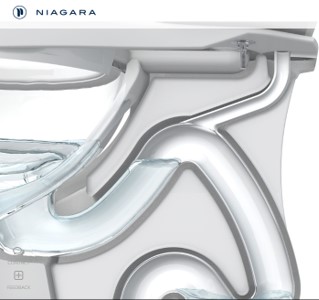
It’s very quiet, which is a little unsatisfying. I didn’t believe the salesman at first: “That toilet can’t flush anything,” I commented, seeing how little water it used and how little sound it made. “Where’s the power?” I asked.
Just then, Teresa Drummond and her husband walked up and said, “This is the best toilet we ever had.” With such perfect timing, I first thought the couple was a plant. But no, they are landlords in Salem, North Carolina. They claim that the Niagara toilet has put an end to clogged-toilet calls from their tenants since they installed them in all of their apartments. The couple owns Green Property Solutions and specializes in energy and water savings for real estate investors. They seemed legit. They love the toilet.
I love new asphalt—the way it feels so smooth beneath my bicycle tires—and I love permeable pavements. Years ago, the combination did not exist. So, I felt a rush of excitement when I saw a water stream draining through a patch of asphalt at Green Build. Joseph Shacat, director of sustainable pavements for the National Asphalt Pavement Association, demonstrated the coarse aggregate formula that turned blacktop into colander pavement.
A typical permeable or porous pavement has an open-graded surface that allows water to penetrate through the pavement and down into a gravel recharge bed, where it will percolate into the soil beneath. In 2005, I pioneered an alleyway of pervious concrete paving in Lincoln, Nebraska, the most northern attempt at the time. The challenge was dealing with freeze/thaw cycles, given snow melt would seep into the concrete and then freeze at night. Porous asphalt has little more flexibility, but in northern climates must still have a design appropriate to weather conditions.
The basic design of a porous asphalt consists of a four-inch layer of standard bituminous pavement with the fines screened or reduced, creating voids that water can run through. The void space of porous asphalt is about 16%, as opposed to 3% for conventional asphalt. Under this pavement come stone fill and geotextile fabric to filter the water and pull it away from the asphalt paving. Keeping the material porous requires periodic vacuuming.
The benefit, from a developer’s perspective, is the ability to pour a perfectly flat parking lot or roadway without concern for sloped surface drainage. Snow tends to disappear from the porous surfaces, requiring less plowing. Unfortunately, porous asphalt is very rough, enough to skin knees, and makes a poor (albeit porous) surface for cycling and skateboarding. Too bad.
At IBS, a glimpse of the future
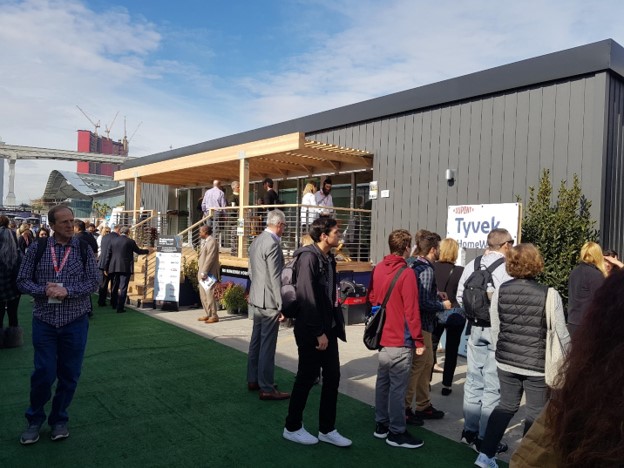
The most exciting products at IBS were not on display, but were promised for a future show. These were products still in research and development. During a remarkable presentation, Diana Hun, of the Building Technology Research and Integration Center, gave attendees a rundown of the work happening at the Department of Energy’s Oak Ridge Laboratory’s (ORNL) toward improving building envelopes.
The research includes studies of vacuum insulated panels (VIP), a technology involving vacuum fibers held in a matrix that yields a whopping R-40 per inch, permitting thin assemblies to achieve high levels of thermal performance. The problem with VIP material mirrors the problem with balloons—a single puncture ruins the whole thing. That’s why it’s not available; this building material remains too delicate to deploy.
The laboratory is working on ways to make VIP technology more durable in the real world of construction. Some of the strategies being tested include encasing the vacuum membrane within polyisocyanurate panels. This polyiso-VIP sandwich reduces the R-value to a still respectable R-12.5 per inch. Other approaches to preserve the higher R-values include a self-healing film that will weld almost instantly after a puncture or cut, and isolating the vacuum elements into a cellular, rather than fiber structure, a little like closed-cell foam, so that damage due to an errant saw or nail affects only the perforated cells and won’t compromise the whole panel.
A potential future application of this super-insulation includes lamination behind vinyl siding so that builders can apply an insulating exterior cladding with significant thermal performance. The siding product remains in the early stages of development in collaboration with Royal Building Materials. It has achieved an R-13 per inch, magnitudes above the current average of about R-2.5 for insulated sidings on the market today.
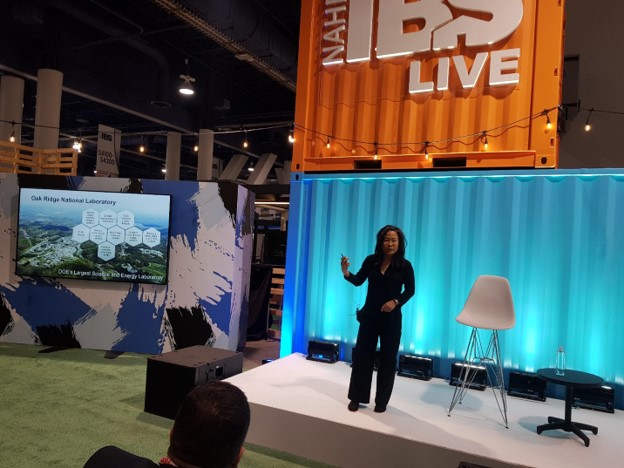
Another cool potentially self-healing product in development would solve the problem with adhesives and caulking that comes with shrinkage and cracking. Self-healing caulking compounds, when cut, or otherwise broken, will expand and bond to reseal the crack—like when you cut your finger, and the skin heals, only more quickly. Hun showed a video of a bead of caulking, under tension, being sliced in two and repairing itself in seconds.
To get more insulation into an insulated concrete form, the scientists at ORNL are working on a thin-wall concrete that will achieve current levels of structural strength with slender profiles—nearly 50% slimmer than existing concrete sections. This means less concrete and more insulation.
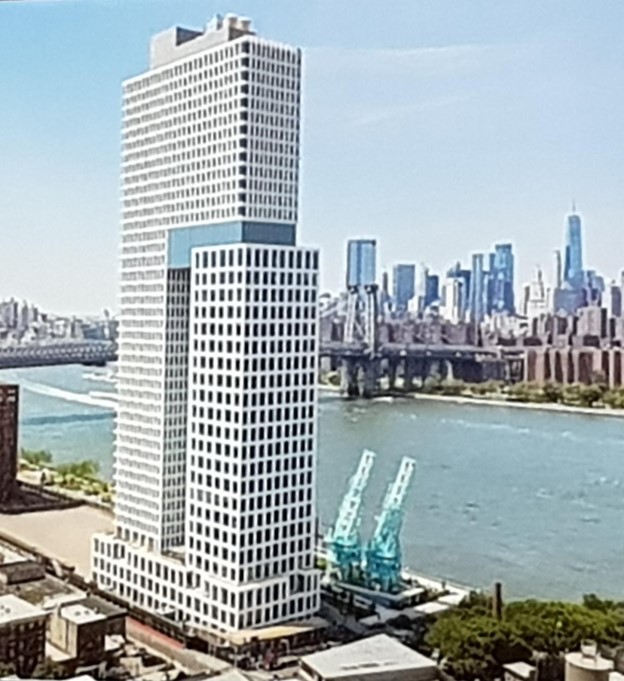
The problem with some alternative energy, such as photovoltaics, boils down to an intermittent source, namely the sun, which shines only in the daytime. For evening consumption, you must store the power. Enter the experimental house-and-car combo under investigation at ORNL. The house charges up the car in the daylight hours, and then the car battery energizes the home at night.

My question, what if the house exhausts the car battery overnight? “Honey, I can’t start the car, you left the TV on all night long!” Never-the-less, there are some promising innovations on the horizon from ORNL. Finally, including a burgeoning house-printing advancement.
Today’s whole-house printers are like inkjet printers that shoot concrete with the cartridge scaffolded inside a large, cumbersome gantry, or frame that holds the extruders. A gantry is cumbersome to set up, and it limits the size of the house to something smaller than the gantry. ORNL has developed a cartridge operated from a standard crane, instead of the gantry. This crane mounted system permits portability while not limiting the size of the building.
Finally, the future of the bathroom
The last two items that I’ll report on from IBS are common bathroom features, with a potentially terrifying twist. The Wize Mirror incorporates a variety of sensors to check your risk factors for cardiometabolic diseases, such as diabetes, heart disease, and stroke. The product, still in development, tracks facial signals related to your health and aims to encourage the man in the mirror to reduce related health risks by improving lifestyle. This could become helpful, and could also be quite irritating.
The Mateo smart bathmat will monitor your weight, posture, and keep track of your shoe size—too bad, it won’t tickle your toes. The contraption hides an array of computerized sensors within a towel-like cover you can throw in the washer machine. The mat has a 7,000-point sensor that identifies the user by foot imprint. Heat sensors monitor the way you distribute your weight, reading your posture. The company provides tailored exercise recommendations to improve your posture while tracking your “posture score” for future reference.
Unlike a traditional scale that reports your weight immediately, the Mateo will store your information and only report on meaningful milestones in weight loss or gain, posture improvements, and for children, changes in foot size, so you know when to buy the kids new shoes.
The company has yet to market the Mateo on a commercial basis. Their high-end unit that will even give you a reading on body composition will retail for $179.00.
These are just a few of many nagging contraptions that point to a future when we will interact with machines even more than we interact with each other. Blessing or curse? I don’t know.
So there you have it, the best in show, at least for me, from Greenbuild 2019 and IBS 2020. I’ll keep walking show floors throughout the year and promise to report back with anything else that catches my eye.
-Fernando Pagés Ruiz is a boutique developer in Colorado and author of two books published by The Taunton Press, Building an Affordable House: Trade Secrets to High-Value, Low-Cost Construction, and Affordable Remodel: How to Get Custom Results on Any Budget. His latest book, Architectural Design for Traditional Neighborhoods, is available as of Sep 2019. Photos courtesy of the author, except where noted.
Weekly Newsletter
Get building science and energy efficiency advice, plus special offers, in your inbox.





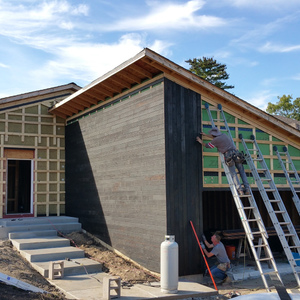

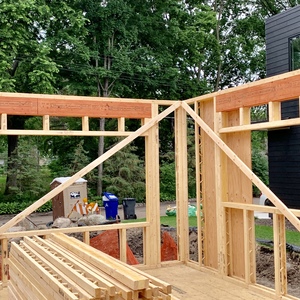
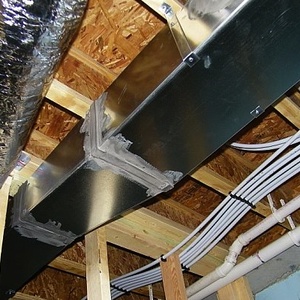






24 Comments
The asphalt product seems promising when applied in parking lots but I'm sure it's ridiculously expensive to implement. Unfortunately the current maintenance requirement makes it unrealistic for use on city streets. Looks promising.
Just another real world review of the Niagara Stealth Toilet.
I live in a village with municipal water and sewer, and I was looking for a low flow toilet so I wasn't literally flushing dollars down the drain. Read about the Niagara Stealth, reviews on Home Depot looked good and pulled the trigger for $150.
It works absolutely fantastic, we have had it for exactly 2 years now and in that time I have had to double flush maybe twice. It just works absurdly well, as you would expect any toilet. That fact that it only costs $150 is tremendous
What does the flush mechanism in the tank look like? Is it one of the three standard types?
“[Deleted]”
Another happy Niagara owner (here it is called Hennessy And Hinchcliffe Watermatrix). All my rental units have them and there have been ZERO issues with them. Even compared to newer dual flush toilets, water use difference is significant.
Malkcom,
The flush assembly is two pieces. There is a pretty standard fill valve and fancier flush assembly:
https://i.ytimg.com/vi/tnhAjJGd_8g/maxresdefault.jpg
No levers to break, no chains to snag, no flappers leaking. This thing just works.
How long have you had them in service?
I have one that is about 10 years old, the rest are between 3 to 5 years old. Whenever one of the older toilets had any issues, I've just been replacing them with these.
Our water up here is very expensive, water costs are comparable to electricity costs, so the return on low flush units that don't need to be double flushed is pretty short.
Any concerns regarding the reduced water flow leading to pipe blockage farther down? This seems to be a concern from plumbers in forums I’ve browsed through over the years.
4” drains and low flow toilets seem to make plumbers nervous, compared to less efficient toilets and 3” pipes.
Lance, Toto has the following note in their instructions for a Drake II 1.0 GPF toilet:
"Ultra-low high efficiency toilets require a system with adequate supplemental flows from other water usage fixtures and a 4” ID drainline with minimum 2% slope and maximum linear runs of 60ft."
From what I understand, having a bathroom sink draining into the same drain "upstream" of the toilet would be sufficient.
I think this low flow toilet boogie man never seems to go away. I remember reading one study that looked at this and it basically only ever becomes a problem with commercial setups where there is a large number of sub 1GPF toilets and nothing else on a horizontal drain.
On any house setup with at most a couple of toilets, plenty of extra water from the shower and the sink, this is a non issue.
I've never had problems with them.
Q tips, hair pins, wet wipes and dental floss are the real problem.
Neat. I was thinking about my plumbing and wondering if I could plumb the shower upstream of the toilet for that very reason. Looks like I'm on the right path!
Yes, I wondered about this "Boogieman" too since a lot of what I've read was posted quite a while ago, and toilets have gotten more stingy since then with seemingly no mass failures to report. No news is good news here.
Lance,
Any blockages would occur a fair distance away from the toilet when the liquids outran the solids. That's well beyond where all the drains in an average bathroom have already merged. You don't need a fixture upstream from the toilet.
I was going to say, I'm not even sure the shower has to be upstream of the toilet, as long as it's close. Of course it's better, but probably not necessary.
Thanks for the info everyone!
I have Niagra Stealth toilets in my house. I love the water savings, the bowl wash not so much. As much as I love the toilet I have to imagine that in a rental situation there could be complaints.
Agreed, in a rental forget it. Decency is lost when people have clogged toilets.
Awaiting ass-wipe comment.
“[Deleted]”
I have a Niagara Stealth (0.8 GPF) and a Toto Drake II 1.0 GPF. I have no major complaints about either. My only minor complaint about the Toto is that it developed a hard water ring at the water line, and I'm not allowed to use normal toilet bowl cleaner to get it off (they say it will damage the cEfiOnTeCt coating.) I might try it anyway. The Niagara is a lot cheaper, so I'd probably choose that in the future.
I'd say go for it since the coating doesn't seem to be doing much if you're getting deposits anyway. Do you use a water softener?
Since you own both, any other feedback? I've read several places (including above) that the bowl wash could be better on the Stealth. Is the Drake II any better/worse? Is the Stealth any quieter than the Drake? Any other nuggets of info you can share? Sorry... :)
The Stealth is in the powder room, so to be honest I haven't really used it enough to comment on the bowl wash. It seems adequate. I also haven't had it as long, maybe 1 year vs almost 3 years for the Toto.
I don't have a water softener. My water isn't the softest, but I don't have problems with hard water deposits anywhere else.
The Stealth sounds like a toilet flushing. It's not loud or usual sounding. The Toto flushes with a satisfying thud. It's a little louder but doesn't bother me.
The Toto is a little more modern looking with it's small tank. The Stealth looks like a generic toilet. But it's a toilet so who cares? The lever feels nicer on the Toto, like solid metal vs. the loose plastic button on the Stealth, but at 3x the price I'd hope so. The Toto seems to be slightly higher quality all around.
I do worry about availability of spare parts if anything breaks. But if that's the biggest trade-off for higher efficiency it's probably worth it. I haven't needed to figure out how each one works, so maybe it's not a big deal. At least Toto has plenty of distributors, and I think only a few different flush mechanisms, so it should be easy enough to get parts.
I have one more rarely used bathroom that still has a low efficiency toilet (more than 1.6 gpf, even). I'll put a Stealth there before I move, or maybe sooner if I ever start using that bathroom regularly. The next owners will save water whether they like it or not!
Haha, thanks for the info Matt!
We have porous pavement in Ann Arbor on streets and parking lots. Has worked well and saves the environment and money. Portland Maine has tried it with a 6 lane major roadway and started to restore a dysfunctional creek near the road within one year (photo). Reports from experts say on roadway freshwater runoff (stormwater) costs 30% of the cost which can be mitigated with porous roadways. U of M has a large porous parking lot in the area that can handle 1,300 inches of rain an hour.
Less pollution as it is detoxified as it percolates through the pores, less cost, less plowing, less salt, 75% less noise, less back ice, no potholes, recharge groundwater, and no freeze-thaw issues as the water quickly drains away from the pavement.
It's good to see the pleased comments about Niagara Stealth toilets. We installed two in our house 4-1/2 years ago, but chose to get the dual-flush models that haven't been mentioned. They have two flush buttons in the middle of the tank top. The large button uses a low 0.95 gals/flush and the small button uses an amazing 0.5 gals/flush. We almost never use the large button. You can barely hear them flush from an adjoining room. MUCH quieter than the explosion of a Flushometer tank.
We have heard of good results using interlocking plastic grid and gravel as an alternative to permeable paving. Area of study was Toronto, Canada and the parking lot was regularly plowed during the winter (aka the plow did not snag the plastic). Cost was about 2/3 to 3/4 per sqft of regular asphalt. Not necessarily a road replacement, but worth examining for a driveway or parking lot.
Log in or create an account to post a comment.
Sign up Log in